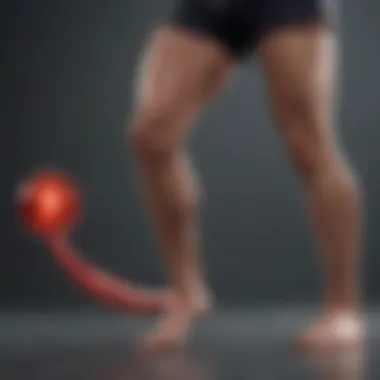Exercises for Orthostatic Hypotension: A Comprehensive Guide


Intro
Orthostatic hypotension is a condition marked by a notable decrease in blood pressure when a person transitions from a lying or sitting position to standing. This phenomenon can lead to dizziness, fainting, or an overall sensation of instability. Understanding how to manage this condition through targeted exercises can significantly improve quality of life for affected individuals. This guide aims to explore exercises that help mitigate symptoms of orthostatic hypotension. By addressing the physiological mechanisms involved and offering practical exercise recommendations, we cater to a wide audience comprised of students, educators, and health practitioners.
Research Highlights
Overview of Key Findings
Research indicates that incorporating physical activity can alleviate symptoms associated with orthostatic hypotension. Exercises designed to strengthen lower body muscles can improve venous return, which is crucial for maintaining blood pressure during postural changes. Studies show that individuals who engage in regular physical activity have a better tolerance for changes in body position, reducing the frequency and severity of symptomatic episodes.
Significance of the Research
The importance of understanding orthostatic hypotension goes beyond mere symptom relief. It provides insights into cardiovascular health and the body’s regulatory mechanisms. Insights from this research guide the development of exercise protocols tailored for individuals at risk of orthostatic hypotension. These protocols enhance not only physical well-being but also contribute to public health initiatives by promoting preventive strategies.
Exercises for Orthostatic Hypotension
Certain exercises are particularly beneficial for those suffering from orthostatic hypotension. These include strength training focused on the lower body, flexibility exercises, and proprioceptive training. Each type of exercise serves a distinct purpose and helps in the overall management of this condition.
Strength training
- Leg raises: These help strengthen the quadriceps and hamstrings.
- Squats: Engages the major muscle groups in the legs and improves overall stability.
- Calf raises: These exercises can enhance blood flow and help maintain pressure during standing.
Flexibility exercises
Incorporating stretches into a routine ensures that muscles remain supple and can adapt better to changes in position.
- Seated toe touch: This simple stretch promotes circulation in the legs.
- Hip flexor stretches: Enhanced flexibility in this area supports better posture and reduced strain during standing.
Proprioceptive training
Balance and spatial awareness are vital when dealing with orthostatic hypotension. Simple exercises such as standing on one leg or using balance boards can hone this skill.
"Engaging in consistent, targeted exercises can become a cornerstone in managing orthostatic hypotension and ultimately enhance daily living for many individuals."
Incorporating these exercises gradually into a daily routine can yield significant benefits. It is important to begin slowly and increase intensity over time while monitoring one’s response to the exercises. Individuals are always encouraged to consult with a healthcare provider before starting any new exercise program. This ensures safety and tailor-fitting exercises to their personal health status.
Understanding Orthostatic Hypotension
Orthostatic hypotension is a medical condition that presents significant implications for one’s health and everyday life. Understanding this condition is vital as it affects many individuals, particularly the elderly and those with certain health issues. It can lead to dizzy spells, fainting and falls, which can cause serious injuries.
This section will explore the definition and symptoms of orthostatic hypotension, its causes, and the physiological mechanisms underlying the condition. This foundational knowledge is essential for anyone interested in managing this issue effectively through specific exercises and lifestyle modifications.
Definition and Symptoms
Orthostatic hypotension is defined as a drop in blood pressure that occurs when a person stands up from sitting or lying down. Normally, when an individual changes position, the body compensates by adjusting blood flow to maintain adequate pressure. However, in orthostatic hypotension, this compensation fails, leading to symptoms such as:
- Dizziness or lightheadedness
- Fainting or near-fainting episodes
- Blurred vision
- Nausea
- Weakness
These symptoms can vary in intensity and may occur immediately or after standing for prolonged periods. Recognizing these symptoms is crucial for individuals who may be at risk, as timely intervention can improve quality of life.
Causes of Orthostatic Hypotension
The causes of orthostatic hypotension are diverse and can be categorized into several types. Some common causes include:
- Dehydration: Reduced fluid intake can lower blood volume, leading to drops in blood pressure.
- Medications: Certain drugs, such as diuretics, beta-blockers or antidepressants, can contribute to this condition.
- Nervous system disorders: Conditions such as Parkinson's disease or multiple system atrophy disrupt the body’s ability to regulate blood pressure.
- Postural changes: Sudden movements, especially in older adults, can trigger symptoms.


Understanding these causes enables better prevention and management through patient education and tailored exercise routines.
Physiological Mechanisms Involved
The physiological mechanisms behind orthostatic hypotension involve several bodily systems, primarily the cardiovascular and nervous systems. The process begins with blood pooling in the lower extremities upon standing, leading to reduced venous return to the heart. This reduction causes decreased cardiac output and, consequently, lowers blood pressure.
The autonomic nervous system plays a critical role in countering this drop. It sends signals to heart and blood vessels to constrict and increase heart rate in order to maintain blood pressure. When this reflex mechanism is impaired, orthostatic hypotension occurs.
Understanding these mechanisms not only provides insight into the condition but also highlights the importance of exercise to strengthen the cardiovascular response and improve overall blood pressure regulation.
In summary, gaining a comprehensive understanding of orthostatic hypotension can aid in recognizing its impact and guides individuals towards appropriate interventions, including exercise, to mitigate symptoms effectively.
The Role of Exercise in Management
Managing orthostatic hypotension (OH) involves various approaches, with exercise emerging as a crucial component. The integration of physical activity not only aids in the regulation of blood pressure but also enhances overall well-being. This section elucidates how exercise influences blood pressure dynamics, the benefits of remaining physically active, and the potential risks linked to inactivity.
How Exercise Affects Blood Pressure Regulation
Exercise plays a significant role in modulating blood pressure. When an individual engages in physical activity, the heart works harder and pumps more blood, which can improve circulation. This increased blood flow helps the body to better manage blood pressure variations upon changing positions, such as standing from a seated position. Furthermore, regular exercise can lead to adaptations in the cardiovascular system, enhancing the efficiency of blood vessels and leading to improved blood pressure control. From a physiological perspective, aerobic exercises can stimulate vasodilation, helping to maintain blood pressure levels during abrupt changes in posture.
"Exercise is not just beneficial; it is essential for effectively managing orthostatic hypotension."
Benefits of Regular Physical Activity
Engaging in regular physical activity offers multiple advantages for individuals experiencing orthostatic hypotension. Some key benefits include:
- Enhanced Cardiovascular Health: Regular exercise strengthens the heart, thus contributing positively to overall cardiovascular efficiency.
- Improved Muscle Tone: Resistance training can help develop the lower body muscles, which assist in venous return and stabilize blood pressure upon standing.
- Increased Stamina and Endurance: With consistent training, individuals often experience heightened energy levels and reduced fatigue.
- Improved Balance and Coordination: Specific exercises, such as tai chi, promote better balance and help prevent falls—an important consideration for those with OH.
- Psychological Benefits: Exercise can also alleviate feelings of anxiety and stress, which may accompany the symptoms of orthostatic hypotension.
These benefits culminate in a more robust physical state that supports the body’s ability to adapt to postural changes.
Risks of Inactivity
While the benefits of exercise are clear, the converse holds true as well. Inactivity can exacerbate symptoms of orthostatic hypotension. Remaining sedentary leads to:
- Deterioration of Muscle Mass: With time, lack of movement can cause muscles, especially in the legs, to weaken. This may diminish the body's ability to support venous return and manage blood pressure effectively.
- Decreased Cardiovascular Fitness: A sedentary lifestyle can impair heart function, leading to less efficient blood pressure regulation.
- Increased Risk of Falls: Poor balance and muscle weakening resulting from inactivity heighten the risk of falls and other accidents.
Types of Exercises for Orthostatic Hypotension
Understanding the types of exercises specifically beneficial for orthostatic hypotension is crucial. Engaging in physical activity can help individuals better manage their condition. The choice of exercises can impact blood circulation, muscle strength, and overall well-being. Different types of exercises provide varied benefits, hence knowing the suitable options is essential for effective management of this condition.
Flexibility Exercises
Importance of Stretching
Stretching serves a fundamental role in enhancing flexibility, which is critical for individuals dealing with orthostatic hypotension. Flexibility exercises promote blood flow and help in maintaining joint health. A key characteristic of stretching is that it can be performed anywhere, requiring minimal equipment. This accessibility makes it a beneficial option for many. The unique feature of these exercises is their ability to improve muscular elasticity, reducing the risk of injuries while exercising. However, individuals must be cautious, as overstretching can lead to discomfort.
Recommended Flexibility Routines
Incorporating specific flexibility routines can augment overall physical management strategies. Recommended routines often include activities like neck rotations, shoulder stretches, and hamstring stretches. These routines are valuable because they can be adapted to fit various fitness levels. The unique feature of these recommended routines is their ability to be integrated into warm-up or cool-down phases of workouts, which aids in blood circulation and prepares muscles for more intense activities. One slight disadvantage might be that without proper guidance, individuals might not stretch sufficiently or effectively enough to yield benefits.
Strength Training
Benefits of Resistance Training
Resistance training plays a significant role in enhancing muscle strength, critical for supporting the cardiovascular system. One of the main benefits of this training type is its positive impact on bone density and metabolism. Another important characteristic is that it promotes functional strength, which is vital for daily tasks. The unique feature of resistance training is its ability to engage multiple muscle groups, enhancing overall fitness. However, care must be taken to avoid overexertion, which can worsen symptoms in some cases.
Suggested Strength Workouts


Suggested strength workouts for individuals with orthostatic hypotension include bodyweight exercises such as squats, lunges, and modified push-ups. These workouts are beneficial because they can be easily tailored to an individual's capacity. They also help in improving muscle tone and endurance, critical factors for overall health. A unique feature of these workouts is that they often do not require any equipment, making them accessible. However, potential drawbacks include the need for proper alignment to prevent injuries.
Aerobic Exercises
Impact of Cardiovascular Fitness
Aerobic exercises significantly influence cardiovascular fitness, which is vital for regulating blood pressure. Engaging in aerobic activities helps to improve heart health and blood flow. A key characteristic is that these exercises elevate heart rate, promoting efficient blood circulation. The unique feature of aerobic activities is the range they offer—from brisk walking to cycling—suitable for various fitness levels. Nevertheless, individuals need to be mindful of their limits to avoid acute fatigue or dizziness.
Examples of Aerobic Activities
Examples of aerobic activities include walking, cycling, swimming, and low-impact aerobics. These activities are popular choices since they can be enjoyed alone or in groups, providing both physical and social benefits. A significant characteristic of these activities is their versatility; they can be modified to suit individual abilities and preferences. The unique benefit of these activities lies in their ability to provide a comprehensive workout that improves endurance and cardiovascular health. On the downside, high-impact versions of these exercises can pose challenges for some individuals, necessitating modifications.
Guidelines for Safe Exercise Practices
Ensuring safety in exercise practices is crucial for individuals with orthostatic hypotension. Patients often experience changes in blood pressure that can lead to dizziness or fainting, particularly during physical activities. Thus, implementing guidelines that promote a safe approach to exercise becomes vital. Following these guidelines can help manage symptoms and enhance overall well-being.
Consulting Healthcare Professionals
Before starting any exercise program, it is essential to consult healthcare professionals. They play a significant role in assessing the individual's condition, providing tailored advice regarding exercise regimens, and considering any underlying health issues. Healthcare providers can offer insight into the specific types of exercises suitable for each individual. They may recommend preliminary tests to determine the safest approaches. Remember that every individual’s condition is unique. Thus, personalized recommendations are very important.
Monitoring Symptoms During Exercise
Continuous monitoring of symptoms during exercise is critical in managing orthostatic hypotension. Individuals should be aware of any signs of dizziness, lightheadedness, or other symptoms that may arise. Keeping a symptom diary can help in this regard. It is recommended to stop the activity immediately if symptoms occur and to take a moment to sit or lie down. Regularly taking note of symptoms can assist in identifying patterns or triggers that may need to be addressed.
Creating a Balanced Exercise Routine
Developing a balanced exercise routine is essential for long-term management of orthostatic hypotension. A well-structured regimen incorporates flexibility, strength, and aerobic exercises to ensure maximal benefits. The routine should be progressive, starting at a manageable intensity and gradually increasing as tolerated. Key components of a balanced routine include:
- Flexibility: Incorporate stretching to improve range of motion and blood flow.
- Strength Training: Use bodyweight exercises or resistance training to build muscle strength.
- Aerobic Exercise: Engage in activities such as swimming, cycling, or walking to enhance cardiovascular health.
It is also vital to incorporate adequate recovery periods to allow the body to adjust, especially for those new to exercise.
"Developing a safe and effective exercise routine is not just about activity; it is a strategic approach to health management."
By adhering to these guidelines, individuals with orthostatic hypotension can engage in physical activity confidently, reducing the risks associated with this condition while promoting better health outcomes.
Sample Exercise Regimen
A well-structured sample exercise regimen is essential for individuals dealing with orthostatic hypotension. Such a regimen helps establish consistency and shows how specific exercises can mitigate symptoms. When individuals have a clear plan, they are more likely to adhere to their routine, facilitating better outcomes in managing their condition.
Weekly Exercise Schedule
Creating a weekly exercise schedule is a foundational step in managing orthostatic hypotension effectively. This schedule should include a mix of flexibility, strength training, and aerobic exercises. Each session should be designed for gradual progression, starting at a comfortable level and increasing intensity as tolerance improves.
A sample weekly schedule could look like this:
- Monday: Flexibility exercises for 30 minutes to promote blood flow and improve range of motion.
- Wednesday: Strength training focusing on large muscle groups, lasting about 30-45 minutes.
- Friday: Aerobic exercise such as brisk walking or cycling for 20-30 minutes.
- Saturday: Light activity such as yoga or stretching to maintain flexibility without overexertion.
It is important to allow recovery days for the body to adapt.
Modifications for Different Fitness Levels
Modifying exercises according to the individual's fitness level is crucial for safety and efficacy. Not everyone will start from the same baseline, and adjustments must be made to cater to varying strength, endurance, and flexibility levels.
- Beginners: Start with low-impact flexibility exercises and light resistance bands. Focus on performing movements in a slow and controlled manner.
- Intermediate: Introduce body-weight exercises like squats and lunges. If comfortable, add moderate resistance for strength training, while still prioritizing balance and stability.
- Advanced: Incorporate complex movements that engage multiple muscle groups. Use free weights or machines to increase resistance as needed. It is also beneficial to include high-intensity interval training for aerobic exercises, provided the individual can handle it without complications.


Regardless of fitness level, monitoring one's response to exercise is crucial. Adjustments should be made based on any symptoms of dizziness or fatigue.
"Listening to your body and adjusting your regimen accordingly can yield the best results while minimizing risks."
In summary, a sample exercise regimen tailored to manage orthostatic hypotension should include a balance of exercises across various domains while considering the individual's fitness level. This approach not only aids adherence but also maximizes benefits, making it an integral component of managing this condition.
Monitoring Progress and Adjustments
Monitoring progress and making adjustments is crucial in managing orthostatic hypotension through exercise. Tracking how well an individual responds to a physical regimen is essential for determining effectiveness and safety. It is also necessary for ensuring that the fitness program is suitably challenging yet achievable. Regular assessments can help identify any necessary changes to maintain motivation and progress.
Setting Realistic Goals
Setting realistic goals is an integral part of any exercise program, especially for those dealing with orthostatic hypotension. Goals provide direction and a sense of accomplishment, which are vital for maintaining focus on the journey toward improvement. These goals should be SMART: specific, measurable, achievable, relevant, and time-bound.
- Specific: Clearly define what you want to achieve, such as improving stamina or strength.
- Measurable: Use quantifiable markers. This could be how long you can stand without symptoms or the number of repetitions you can perform.
- Achievable: Ensure that the goals are within reach based on current health status and fitness levels.
- Relevant: Align goals with personal aspirations and health requirements to promote commitment.
- Time-bound: Set deadlines to provide urgency and maintain focus.
Remember, flexibility is a key when setting goals. As you progress and experience changes, you may need to adapt your objectives to better align with your evolving fitness level.
Tracking Improvements Over Time
Tracking improvements over time is essential to evaluate the effectiveness of the exercise program. This can involve several methods:
- Journaling: Keep a detailed record of daily exercises, duration, and symptoms experienced.
- Regular Assessments: Scheduled evaluations such as blood pressure readings can help monitor changes in orthostatic response.
- Feedback from Health Professionals: Engaging with healthcare providers ensures that you are on the right path and can clarify any doubt about your progress.
Tracking allows for meaningful reflections on what works and what does not. If a specific exercise or routine does not yield improvements, it may be time to reconsider the approach.
"Regularly tracking your progress helps to sustain motivation and guides modifications needed for future success."
Complementary Strategies to Enhance Effectiveness
Orthostatic hypotension presents unique challenges, and exercises alone may not fully address the symptoms. Thus, integrating complementary strategies is essential. These strategies enhance the effects of physical activity and provide a holistic approach to management. Key areas include nutrition and hydration, both of which play pivotal roles in stabilizing blood pressure.
Nutrition and Dietary Considerations
Eating well is foundational in managing orthostatic hypotension. A balanced diet can influence blood volume and circulation, impacting blood pressure regulation. Important considerations are:
- Increased Sodium Intake: Sodium helps retain water in the body. Including foods like pickles, olives, and salted nuts can be beneficial. However, individuals should consult healthcare providers before making significant dietary adjustments, especially those with heart conditions.
- Hydration: Dehydration can exacerbate symptoms. A diet rich in fluids, particularly water, is essential for maintaining blood volume.
- Balanced Diet: Consuming a variety of foods ensures adequate vitamin and mineral intake, essential for vascular health. Focus on fruits, vegetables, whole grains, and lean proteins.
Adopting these dietary measures can create a supportive environment for individuals managing orthostatic hypotension.
Hydration and Orthostatic Hypotension
Hydration is critical in preventing a drastic decline in blood pressure when standing. Staying hydrated can improve blood volume and reduce risks associated with orthostatic hypotension. Practical ways to enhance hydration include:
- Regular Water Intake: Aim for consistent fluid consumption throughout the day, rather than large amounts at once.
- Electrolyte Beverages: Drinks containing electrolytes can help balance fluids in the body, especially after exercise or in hot weather.
- Monitoring Symptoms: Pay attention to signs of dehydration such as increased dizziness or fatigue. Adjusting fluid intake accordingly can mitigate these symptoms.
To summarize, hydration and nutrition should be integral components of any strategy aimed at managing orthostatic hypotension. These elements not only complement exercise but also facilitate better overall health.
Finale
In this article, we have explored the significant role of exercise in managing orthostatic hypotension. This condition, which causes a notable drop in blood pressure when transitioning from sitting to standing, can be particularly challenging for many individuals. The exercises discussed—ranging from flexibility routines to aerobic activities—are not just designed to address the symptoms, but also work on the underlying physiological mechanisms at play.
Summary of Key Points
- Understanding of Orthostatic Hypotension: Knowing the definition, symptoms, and causes is crucial for effective management.
- Role of Exercise: Physical activity can improve blood pressure regulation and overall cardiovascular health. Regular exercise is beneficial not only for symptom relief but also for enhancing general well-being.
- Exercise Types: Flexibility, strength training, and aerobic exercises were identified as key components of an effective regimen. Each type contributes uniquely to physical stability and blood circulation.
- Guidelines for Safety: Consulting healthcare professionals allows individuals to tailor their exercise plans safely. Monitoring symptoms during activity is essential to avoid adverse effects.
- Complementary Strategies: Appropriate nutrition and hydration significantly impact activity effectiveness and overall management of orthostatic hypotension.
Future Directions in Research and Practice
Looking ahead, further research could focus on the specific types of exercises that yield the most beneficial results for individuals with orthostatic hypotension. Examining the long-term effects of different exercise regimens on blood pressure stability will be vital. Moreover, studies could investigate how factors like age, gender, and comorbid conditions affect exercise outcomes.
In practice, healthcare providers should consider creating more structured exercise programs tailored to the unique needs of patients suffering from this condition. Collaboration between physical therapists and primary care doctors may result in better integration of exercise into treatment plans. The use of technology, such as wearable devices to monitor blood pressure in real-time during exercise, could enhance safety and efficacy.
In summary, exercise offers a promising strategy for those dealing with orthostatic hypotension. With well-informed approaches and ongoing research, individuals can engage in physical activity with greater confidence, improving both their immediate symptoms and long-term health outcomes.







